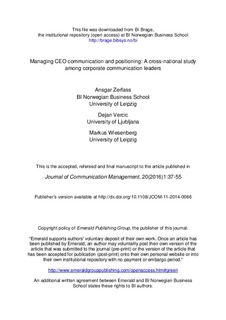Managing CEO communication and positioning: A cross-national study among corporate communication leaders
Journal article, Peer reviewed
Permanent lenke
http://hdl.handle.net/11250/2423408Utgivelsesdato
2016Metadata
Vis full innførselSamlinger
- Scientific articles [2181]
Originalversjon
Journal of Communication Management, 20(2016)1:37-55 http://dx.doi.org/10.1108/JCOM-11-2014-0066Sammendrag
Purpose
– The purpose of this paper is to examine the practices of positioning Chief Executive Officers (CEOs) and other top executives in the public sphere and approaches to manage their communication activities.
Design/methodology/approach
– A neo-institutional framework is used to explain the growth of CEO positioning in mediatisated societies. Research questions are derived from previous research and tested in a quantitative online survey with 512 heads of corporate communication in 21 countries across Europe and a qualitative survey with 42 communication leaders in 12 countries.
Findings
– The majority of companies position their CEOs and/or other top executives, but only a minority guide these activities through a sound management process. European CEOs are primarily presented based on their functional and ethical competencies. A minority of communication leaders prefer the uniform positioning of their CEOs in different markets; others argue for localised approaches. More companies in high-power distance countries have a specific communication strategy for their CEOs, compared to companies in low-power distance countries. Significant differences were also identified between listed and privately owned companies.
Research limitations/implications
– The study indicates the importance of CEO positioning from the perspective of corporate communication leaders. Investigating the expectations and experiences of CEOs themselves might provide additional insights.
Originality/value
– The paper presents the first large-scale study on CEO positioning, informs practitioners on the state of practice in Europe and identifies knowledge that can be integrated into education of business and communications students alike.
Beskrivelse
This is the accepted, refereed and final manuscript to the article
